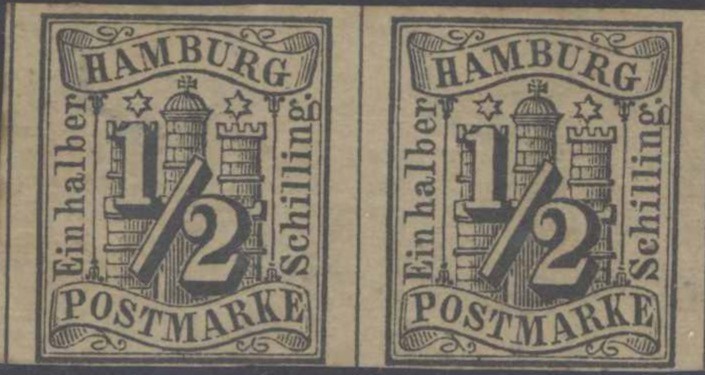
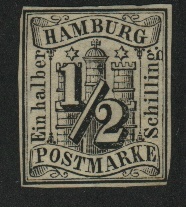
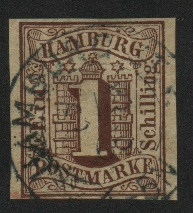

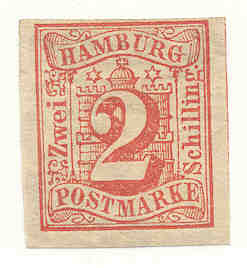
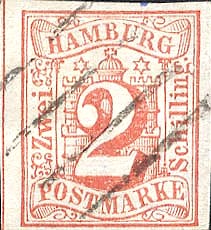
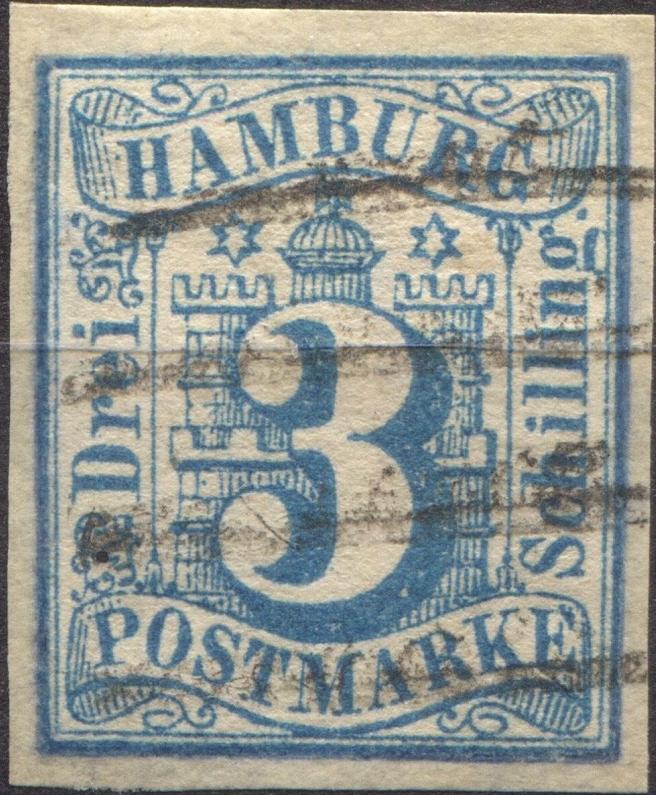
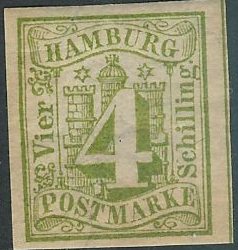
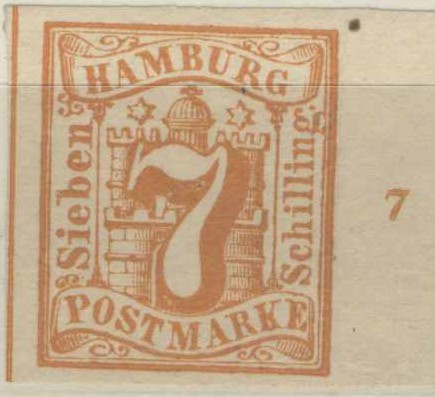
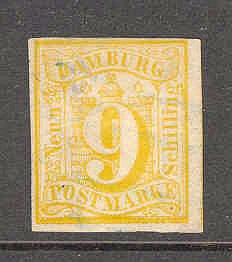

Return To Catalogue - Hamburg, cancels - Hamburg, forgeries of the 1859 issue - Miscellaneous - Private issues (Boten issues), part 1 - Private issues (Boten issues), part 2 - Private issues (Boten issues), part 3 - Other private issues
Currency: 1 Hamburg Mark = 16 Schilling
Note: on my website many of the
pictures can not be seen! They are of course present in the cd's;
contact me if you want to purchase them: evert@klaseboer.com.
1/2 Schilling black 1 Schilling brown 2 Schilling red 2 1/2 Schilling green (1867, perforated only) 3 Schilling blue 4 Schilling green 7 Schilling orange 7 Schilling lilac (1865, only issued perforated) 9 Schilling yellow
These stamps should have a watermark 'single wavy line' (or sometimes called 'bell-curved', for an example of this watermark see the 1864 issue). Actually, the whole sheet has 12 wavy lines, surrounded by a square (which can sometimes be seen on the outer stamps of the sheet). All the forgeries don't have this watermark. The first stamps were issued on 1st January 1859.
Value of the stamps |
|||
vc = very common c = common * = not so common ** = uncommon |
*** = very uncommon R = rare RR = very rare RRR = extremely rare |
||
| Value | Unused | Used | Remarks |
| Imperforate | |||
| 1/2 s | RR | RRR | To be used for printed matter to Ritzebuttel, Bremen,
Lubeck, and Oldenburg. Later also for letters to Altona and local letters. Bisected provisionals exist to make up the 1 1/4 s rate (unofficial). |
| 1 s | RR | RR | To be used on local letters, letters to Bergedorf and
printed matter to Helgoland, The Netherlands and Great Britain. |
| 2 s | RR | RR | To be used as letter rate for other towns in Hamburg and Lubeck. |
| 3 s | RR | RR | Shades of blue. To be used on letters to Bremen and most of Oldenburg. |
| 4 s | RR | RRR | To be used on letters to Helgoland and certain towns in Oldenburg. |
| 7 s orange | RR | RR | To be used for letters to the Netherlands (after 1st
July 1859 also to Great Britain and Ireland). |
| 9 s | RRR | RRR | To be used for letters to Great Britain and Ireland
at first. Also used for other foreign letters. |
| Perforated 13 1/2 (appeared between September 1864 and April 1865) | |||
| 1/2 s | *** | *** | |
| 1 s | *** | R | |
| 2 s | R | R | Could also be used on money orders to Schleswig
Holstein and for the registration fee on letters in Hamburg. Also in use for letters to Helgoland. |
| 2 1/2 s | R | R | Issued June 1867. |
| 3 s | R | RR | Shades of blue |
| 4 s | *** | R | |
| 7 s orange | RRR | RRR | |
| 7 s lilac | *** | *** | |
| 9 s | *** | RRR | |
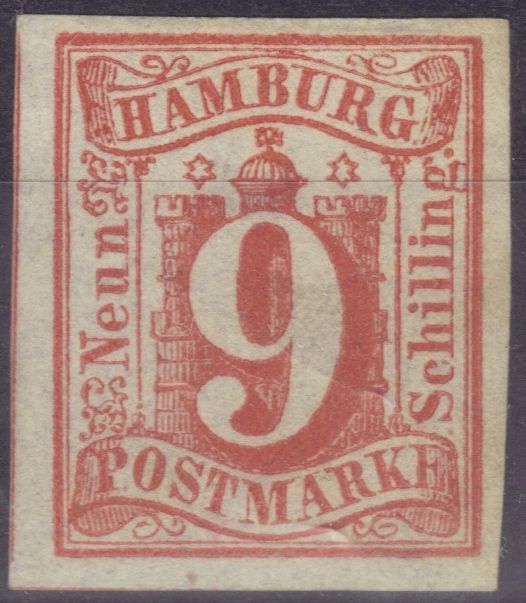
I've been told that this is a color proof: 9 sch red.
The remainders of the perforated stamps were sold without gum in 1869 to Julius Goldner, a stamp dealer in Hamburg.
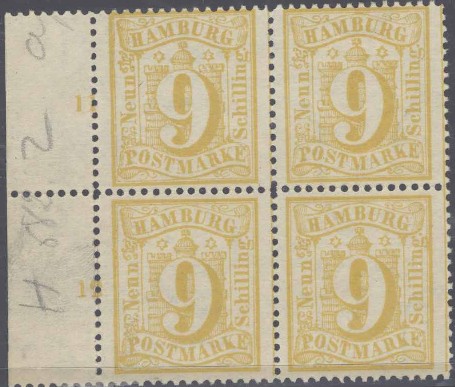
Block of four 9 s stamps, with numbers in the left margin.
Click here for Hamburg, cancels. Forged cancels are also described here.
Since the perforated stamps are much cheaper than the imperforate ones, often the perforation has been cut from these cheaper stamps, to make them appear 'imperforate'! Click here for more information about forgeries of this issue. In the Philatelic Journal of America March 1893, No 111, page 122, in an article translated from Hugo Krotzsch, it is said that: "As early as 1864 the 7 and 9 sch., of the first issue, appeared in counterfeits made in Hamburg."
Instruction stamps (Instruktionsmarken):
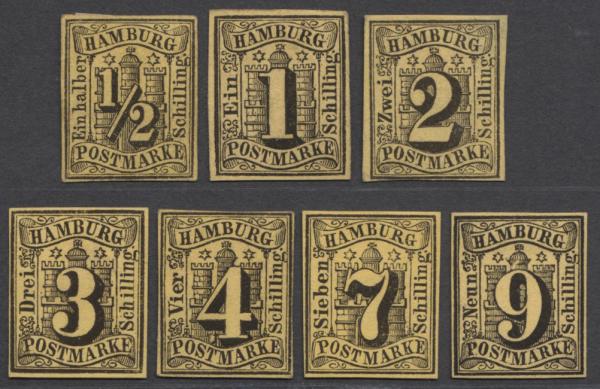
Instruction stamps
I've seen 1/2 s, 1 s, 2 s, 3 s, 4 s, 7 s and 9 s imperforate in black on yellow paper. I've been told that these are 'instruction stamps'. They were pasted on parcels of stamps, such that the clerks at the post office could easily identify which stamps were in which parcel. The only reference I could find about these stamps is in K.K.Doberer "Die Briefmarken von Altdeutschland" under the Bavaria(!) section.
1 1/4 Schilling lilac 2 1/2 Schilling green
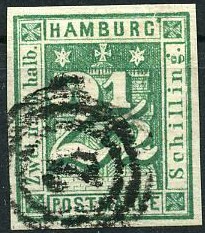
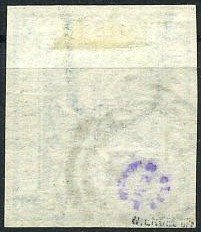
2 1/2 Sch with watermark seen from the backside with a numeral
'2' Danish postmark.
Value of the stamps |
|||
vc = very common c = common * = not so common ** = uncommon |
*** = very uncommon R = rare RR = very rare RRR = extremely rare |
||
| Value | Unused | Used | Remarks |
| Imperforate | |||
| 1 1/4 s | RR | RR | Shades varying from violet to grey. To be used for
letters to Schleswig-Holstein and Denmark. Printed in sheets of 192 stamps. Reprint: c |
| 2 1/2 s | RR | RR | For letters to Denmark after 2nd April 1864. Printed in sheets of 192 stamps Reprint: c |
| Perforated 13 1/2 | |||
| 1 1/4 s | RR | *** | Reprint: c |
| 2 1/2 s | RR | R | Reprint: c |
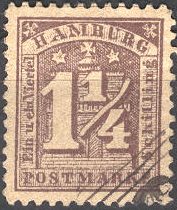
Probably a reprint.
For the specialist: these stamps have a watermark
wavy lines. Reprints were made in 1872, but these reprints don't
have any watermark, are printed on yellowish paper and
have thinner 'guidelines' between the stamps. Genuine stamps have
perforation 13 1/2. Some reprints have perforation 11 1/2.
The reprints exist in all kind of color shades (as the genuine
stamps). They were made by the printer of the genuine stamps
C.Adler of Hamburg and later sold by the stamp dealer Julius Goldner. At first
the same perforation machines were used as for the genuine
stamps, but later a new perforation machine which perforated the
stamps 11 1/2 instead of 13 1/2 was used.
A very small number of reprints on watermarked
paper also exist. Goldner also ordered
some reprints of non-existing essays (on unwatermarked paper)
with the colors inverted, thus 1 1/4 s green and 2 1/2 s lilac.
Furthermore some phantasy prints were made of both stamps in
bogus colors. For a full description of the history of these
reprints, see Ohrt, Handbuch der Neudrucke (in German).
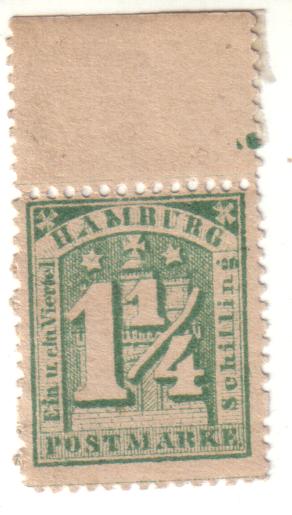
'Essay' reprint of a 1 1/4 Sch green

'Essay' reprints in various colors.
Forgeries are relatively much less common than reprints, but they do exist. The Serrane guide says that forgeries exist from Geneva (Fournier) and Charlottenburg. Some examples:
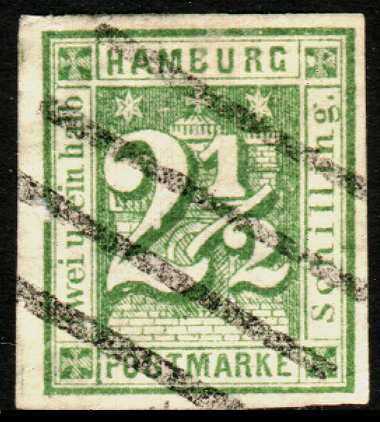
This is probably a forgery, the letters are different, for
example the 'g' of 'Schilling' is placed too much to the right
and does not touch the line to the left of it. There is no dot
behind the word 'halb'.
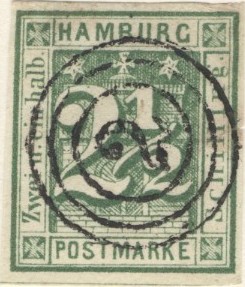

This is possibly the first forgery described in Album Weeds: the
dot behind 'g' of 'Schilling' is placed too high. The third
row of bricks seen from the bottom is slightly thinner
than the other two layers.
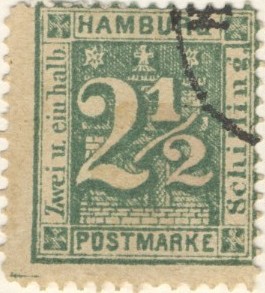
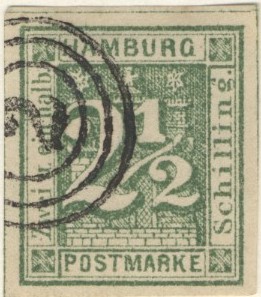
Second forgery of the 2 1/2 Sch of Album Weeds. The first
layer of bricks at the bottom of the stamp is about
twice as thick as the second and third layer. Also, the dot
behind the 'g' of 'Schilling' is placed too close to the square
above it (it should be evenly placed between the 'g' and this
square). The numeral cancel '2' as shown on the second forgery
does exist as a genuine cancel (Danish cancel). In Ragatz'
Fournier Album such a forgery can also be found, but perforated
12 1/2 (as in the above forgery; genuine Hamburg stamps always
have perforation 13 1/2). I've also seen the imperforate stamp
with a parallel lines cancel. Click here
for other German States forgeries which were probably made by the
same forger.

Very dubious item. The 'c' of 'Schilling' is different.

Another highly dubious 2 1/2 Sch stamp. The star above the large
'2' almost touches the '2'. The crosses in the corners don't have
any shading.
I've seen a Fournier forgery of the 1 1/4 Sch stamp with cancel 'HAMBURG BAHNHOF 21 11 65 8-10 1/2 N' in a single circle as described behind the 1859 issue. Fournier also sold forgeries of the 2 1/2 Sch value.
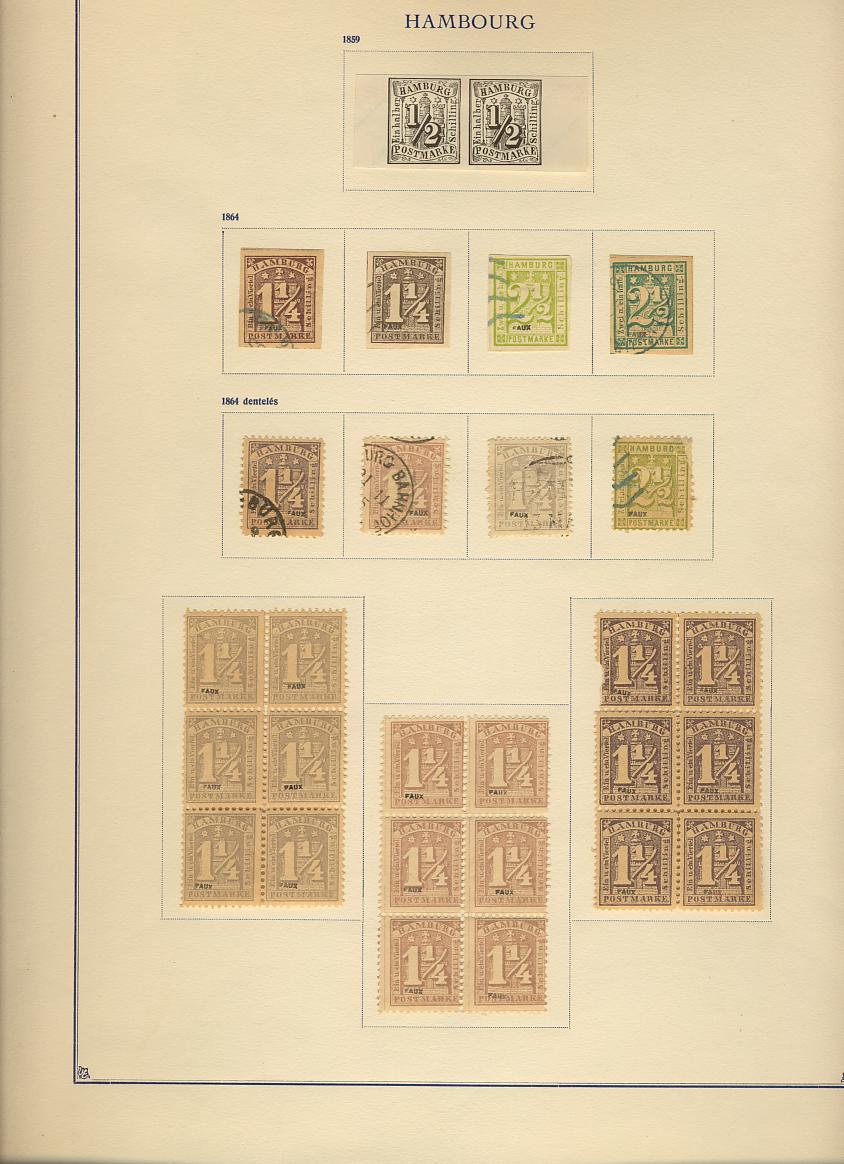
A page of a Fournier Album with forgeries of the 1 1/4 and 2 1/2
Sch; Fournier seems to have sold many shaded of these forgeries.
I'm not sure if Fournier actually made a new set of forgeries, or
sold the reprints as mentioned above.
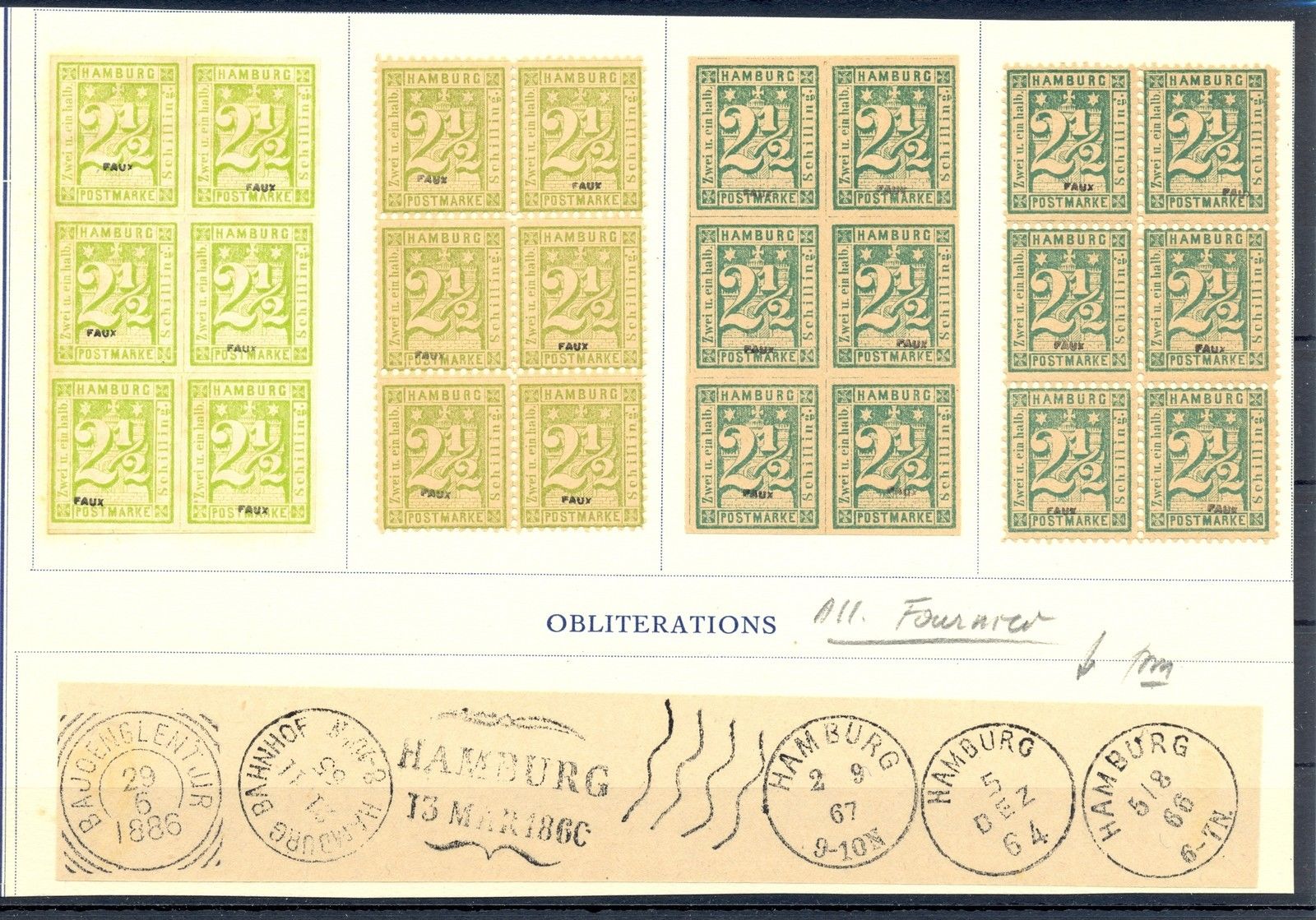
Another page from a Fournier album

Fournier's forged cancels taken from a Fournier Album, reduced
sizes

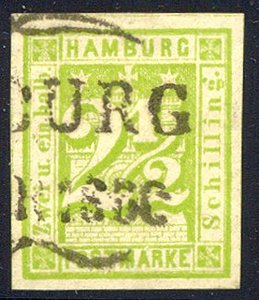
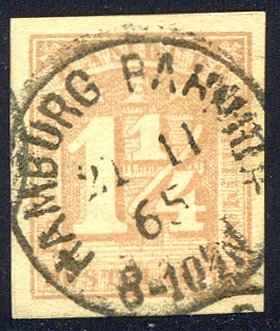
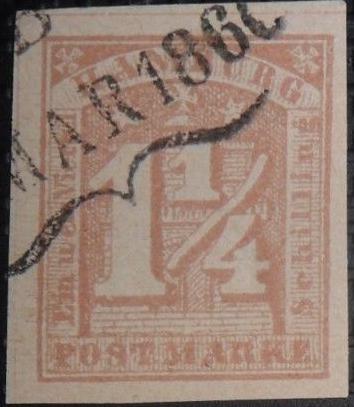
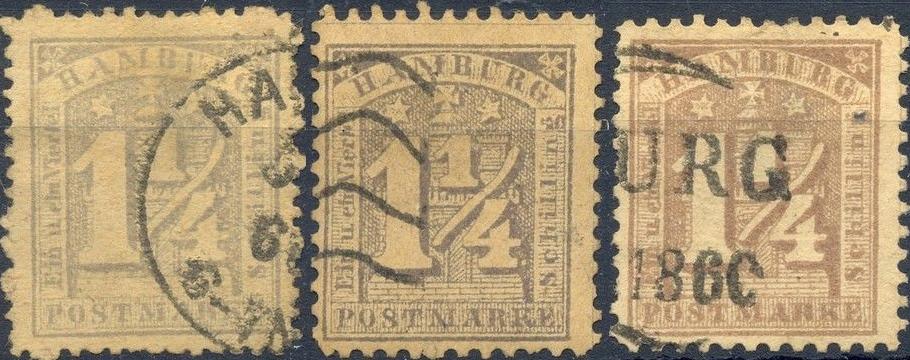
Probably Fournier forgeries, they have the same cancels as shown
above in the Fournier Album.
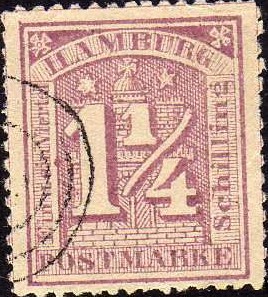
Other forgery of the 1 1/4 s stamp. There is no '.' behind the
word 'POSTMARKE'. Album Weeds describes three different types of
forgeries without this dot behind 'POSTMARKE'.
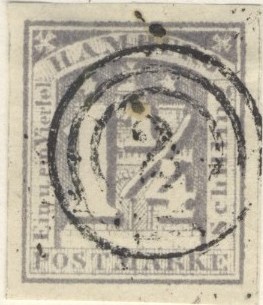
Other forgery of without dot behind 'POSTMARKE'. The 'A' of
'HAMBURG' has no upper serif.

(Probably genuine stamps)
1 1/4 Schilling violet 1 1/2 Schilling red
Value of the stamps |
|||
vc = very common c = common * = not so common ** = uncommon |
*** = very uncommon R = rare RR = very rare RRR = extremely rare |
||
| Value | Unused | Used | Remarks |
| 1 1/4 s | R | R | Printed in sheets of 100 stamps (10 rows of 10). |
| 1 1/2 s | *** | RR | Printed in sheets of 100 stamps (10 rows of 10). |
These stamps were manufactured by the Prussian State Printing Office in Berlin.
Reprints of these two stamps exist:
The genuine 1 1/4 Sch stamps have a small white
circle in the stars (this is filled up in the reprints). The
triangles in the corners are different from the genuines 1 1/4
Sch stamp (they were attached using a postal stationery as I
understand it); the thickness of the inner two lines is
different. There are also differences in the 'g' of 'Schilling'
in the reprints compared to the original stamps, in the genuine
stamps there is a small line going trough the upper open part of
this letter which is missing in the reprint.
The 1 1/2 Sch reprints are printed on much
thicker paper. There are again differences in the 'g' of
'Schilling' in the reprints compared to the original stamps, in
this case however, there is a line going halfway through the
upper part of the 'g', but this line is not present in the
genuine stamp.
Source: 'The Forged Stamps of all Countries' by J.Dorn. Examples
of what I think are reprints:
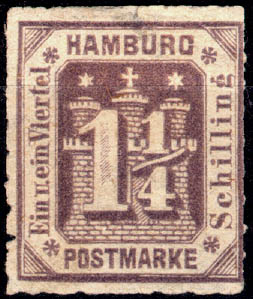

(Probably reprints, in the lower left part of the 1 1/4 stamp,
the attached triangle can be seen)
Modern reprints also exist (made by Gehringer in Kaiserslautern).


Forgery of the 1 1/2 Sch value. The first row of bricks above the
word 'POSTMARKE' has a brick just above the 'O' of this word. In
the genuine stamp this letter comes just below two bricks. The
lettering and design is also slightly different.
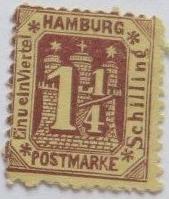
Forgery, lettering different. For example the 'P' of 'POSTMARKE'
almost touches the star in front of it.

Gehringer 'reprints' made in 1978.
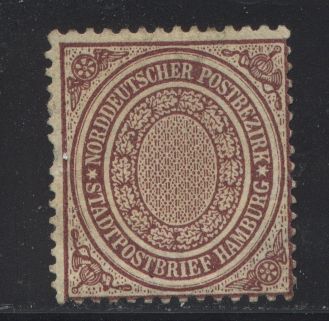
A special local stamp for Hamburg was issued by the North German Federation (due to the
differency in currency used in Hamburg)
The forger Julius Goldner made enormous quantities of private reprints of Hamburg. These reprints do not have any watermark.

The above minisheet of 1 1/4 Sch stamps was printed for the Mophila Exhibition in 1931. It has a watermark like pattern in the paper. The paper below the stamps is more yellowish and on the backside traces of threads can be seen. The stamps are rouletted.
In 1978, the printer Gehringer of Kaiserslautern made reprints of the 1 1/4 Sch and 1 1/2 Sch stamps. Enormous quantities must have been printed, the quality is very good (the embossing on the backside of the stamp can clearly be seen).

(Reprint consisting of a block of four 1 1/4 Sch stamps, for the
'WELTPOSTKONGRESS' in Hamburg, I've also seen these sheets
without the Weltpostkongress text, note there is watermark alike
pattern in the whole sheet)
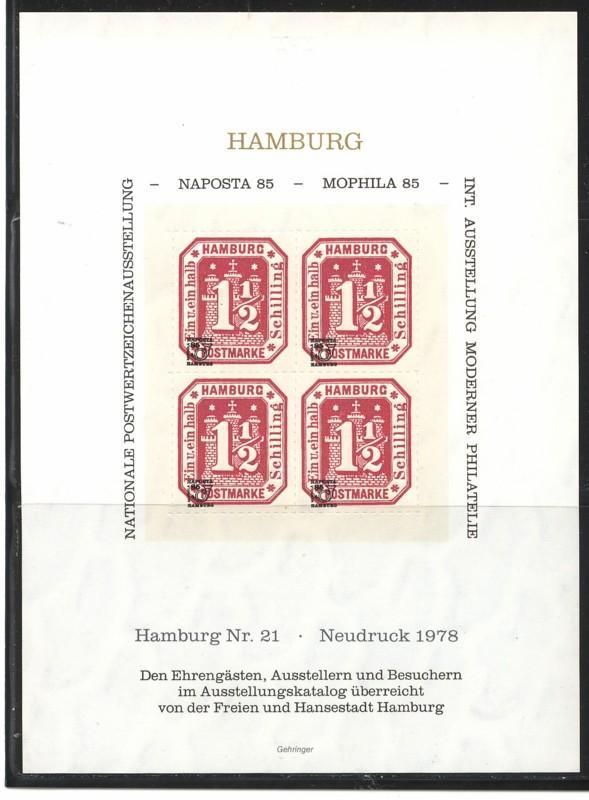
Gehringer mini sheet reprint containing four 1 1/2 Sch stamp for
'NAPOSTA 85' and 'MOPHILA 85'
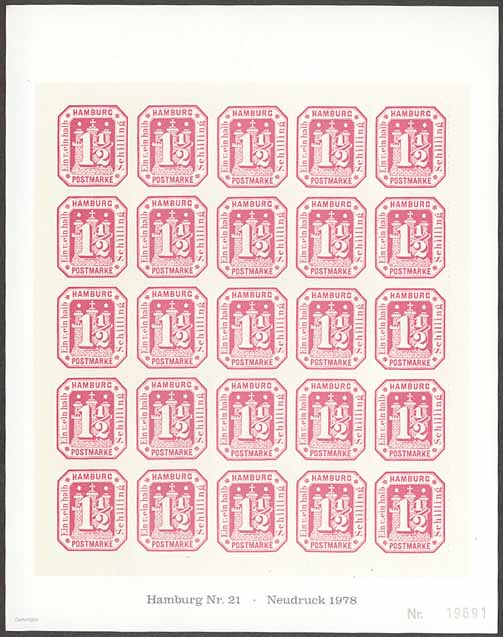
A whole sheet of Gehringer reprints containing 25 stamps of the 1
1/2 Sch value, inscription 'Hamburg Nr. 21 - Neudruck 1978'
Similar sheets exist with the value 1 1/4 Sch (also 25 stamps).

(Cut from such a sheet, reduced size)